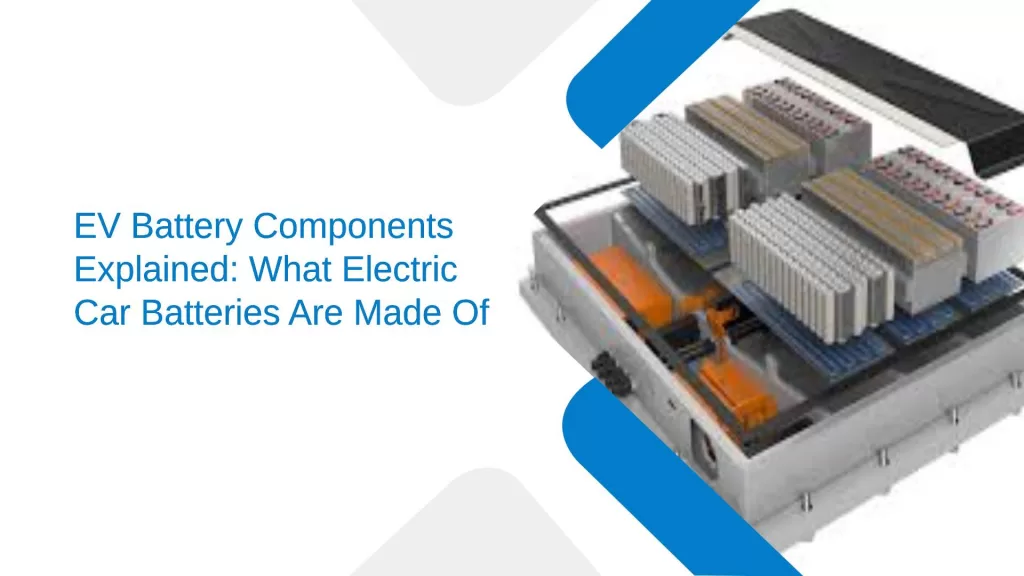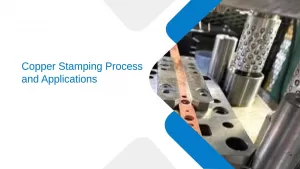EV Battery Components Explained: What Electric Car Batteries Are Made Of
- EV Components |
- Nov 21, 2025

Have you ever wondered what really powers an electric car? It isn’t the motor that is listed on the specification sheet, but it is the EV battery that is hidden deep inside the car. This cutting-edge electric vehicle battery is made of numerous intelligent parts that cooperate to provide energy storage, heat control, and continuous power for each ride. When we mention electric car battery parts, we actually mean the heart of an electric car.
What Are EV Battery Components
An EV battery consists of layers, and each of the layers has a specific function in the storage and delivery of power. Instead of having one massive energy block, the battery is composed of many small parts that interact and operate as a single efficient system. An EV battery has three main levels of structure:
Cells
These are the smallest units. A single cell holds a small amount of energy.
Electrochemical components
- Cathode (e.g., NMC, NCA, LFP materials)
- Anode (usually graphite, sometimes silicon-graphite)
- Separator (micro-porous membrane preventing short circuits)
- Electrolyte (lithium salts in organic solvents enabling ion flow)
- Current collectors
- Cell casing (steel, aluminum, or laminated polymer for pouches)
Modules
A module is a group of many cells packed together for mechanical stability and easier thermal/electrical management.
Typical module components:
- Cell interconnects / busbars
- Voltage/current/temperature sensors
- Structural frame or enclosure
- Foam/fillers for impact and vibration protection
Pack
This is the full electric battery system inside the car. It includes modules, cooling pipes, safety features, sensors, and a strong outer case.
Electrical systems
- Battery Management System (BMS)
- High-voltage junction box (HVJB)
- Contactors & relays
- Fuses / circuit breakers
- Wiring harnesses & connectors
Thermal management components
- Liquid cooling plates or tubes
- Heat pumps or chillers
- Thermal interface materials (TIM)
- Coolant and circulation pumps
Mechanical structures
- Pack enclosure/housing
- Crash protection structures
- Seals & gaskets (moisture, dust, and thermal isolation)
All these parts work together to send power to the motor. This is why car battery parts in EVs are far more advanced than those in fuel-powered cars.
Inside the Cell: Materials and Chemistry
Every EV battery cell has four main internal parts. Each one plays a clear role in storing and releasing energy.
Cathode: The cathode decides most of the battery’s range and cost. It is constructed utilising lithium together with nickel-manganese-cobalt (NMC), nickel-cobalt-aluminium (NCA), or iron phosphate (LFP) combination.
Anode: Anode material is generally graphite. Additionally, some upcoming electric vehicles are using silicon-based anodes to get better range.
Electrolyte: It is a liquid or solid material that allows the lithium ions to move back and forth between the cathode and anode.
Separator: A very thin film that separates the two sides so that short circuits do not occur.
The term battery chemistry refers to the blending of these materials together. The NMC, NCA, and LFP are the most widely adopted chemistries. Each of them has different critical parameters in terms of ranges, being safe, cost, and life. When it comes to the parts of an EV battery, one of the major characteristics that need to be considered is the chemical composition of the cell.
Types of Batteries Used in Electric Vehicles
There is a large number of people who are intrigued by the question “What battery do electric vehicles use?” Because there are several types of batteries used in electric vehicles, each one has its advantages depending on the characteristics of the vehicle.
Lithium-Ion Batteries: These are the primary battery types that are still in operation in electric vehicles. They provide a powerful range, excellent safety, and long life.
Nickel-Metal Hydride: They were used in the earlier hybrids. Their safety was good, but the energy density was lower.
Solid-State Batteries: A novel invention that substitutes a liquid electrolyte with a solid material. They offer better safety and longer range at the same time. These are still under development.
Lead-Acid and Other Chemistries: Used only for low-voltage tasks, not for driving the vehicle.
The answer to “which battery is used in electric vehicles?” is almost always lithium-ion today.
Supporting EV Battery Components
A modern EV battery pack is much more than cells. It has many supporting systems that keep the battery safe, cool, and under control.
Battery Management System: A digital control unit that observes the temperature, voltage, and battery health. It stops the battery when overcharging or overheating is detected.
Thermal Management System: The battery is kept cool by using pipes, plates, or liquid coolant.
Casing and Cooling Plates: The battery pack is protected by a very hard outer case from heat, impact, dust, and water.
Wiring Harness and Connectors: The battery, motor, charger, and BMS get connected through these, which help in the transfer of energy.
All of these are key EV battery components that ensure safe performance.
Materials Used in EV Batteries
Many elements play a role in battery function:
- Lithium: Main energy carrier
- Nickel: Improves energy density
- Cobalt: Adds stability
- Manganese: Helps balance chemistry
- Aluminium: Used in pack frames and some cell chemistries
- Graphite: Used in the anode
Sustainability has turned into a major problem. To name but a few, businesses are being less dependent on cobalt, making the recycling of EV batteries more efficient, and playing it safe with new chemistries such as LFP and solid-state.
Applications and Future of EV Battery Technology
The EV battery design is experiencing a rapid change. The new solid-state batteries will have the ability to last longer and be charged faster. Battery packs are being redesigned in a manner that cars are becoming lighter and more power-efficient. New recycling methods are developed whereby the recovery of metals takes place along with waste reduction.
Future EV batteries may power:
- Electric trucks with long-range needs
- Aircraft and drones
- Large energy storage systems for solar and wind power
By the use of superior materials and modern technologies, the future electric vehicle battery systems will be the safest, the efficient, and most powerful ever.
Read More: How Electrical Stamping Manufacturers Are Supporting the EV Boom
Conclusion
Electric vehicle batteries consist of several cells, modules, and packs along with many advanced systems working together to drive the future of electric mobility. The technology of batteries will continue the trend of new materials and smarter designs to determine how far and how fast now and in the future to come EVs can go.
If you are looking for precision-made metal parts for your EV battery trays, busbars, stamping, or advanced connectors, Eigen Engineering provides top-quality custom solutions for modern EV systems. Visit us today to explore our advanced engineering and metal fabrication services.




